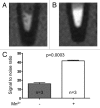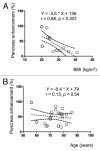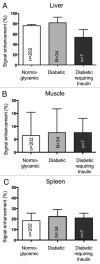Pancreatic magnetic resonance imaging after manganese injection distinguishes type 2 diabetic and normoglycemic patients
- PMID: 22722479
- PMCID: PMC3442822
- DOI: 10.4161/isl.20857
Pancreatic magnetic resonance imaging after manganese injection distinguishes type 2 diabetic and normoglycemic patients
Abstract
A non-invasive method to image the mass and/or function of human pancreatic islets is needed to monitor the progression of diabetes, and the effect of therapeutic interventions. As yet, no method is available for this purpose, which could be applied to in situ human islets. Animal and in vitro studies have documented that manganese infusion could improve the magnetic resonance imaging (MRI) of the endocrine pancreas. Here, we have tested whether a similar approach could discriminate diabetic and non-diabetic patients. In vitro, human isolated islets readily incorporated manganese. In vivo, 243 manganese-enhanced magnetic resonance imaging (MEMRI) examinations were reviewed, including 41 examinations which were run on 24 patients with type 2 diabetes and 202 examinations which were run on 119 normoglycemic patients. The results show that MEMRI discriminates type 2 diabetics from non-diabetic patients, based on the signal enhancement of pancreas.
Figures




Similar articles
-
Mangafodipir trisodium (MnDPDP)-enhanced magnetic resonance imaging of the liver and pancreas.Acta Radiol Suppl. 1998;415:1-31. Acta Radiol Suppl. 1998. PMID: 9571956
-
Toward clinical application of manganese-enhanced MRI of retinal function.Brain Res Bull. 2010 Feb 15;81(2-3):333-8. doi: 10.1016/j.brainresbull.2009.06.002. Epub 2009 Jun 11. Brain Res Bull. 2010. PMID: 19524028 Free PMC article.
-
[Mangafodipir trisodium-enhanced magnetic resonance cholangiography for detection of bile leaks].J Radiol. 2006 Jan;87(1):41-7. doi: 10.1016/s0221-0363(06)73968-3. J Radiol. 2006. PMID: 16415779 French.
-
Unexpected MR-T1 enhancement of endocrine liver metastases with mangafodipir.J Magn Reson Imaging. 1999 Aug;10(2):193-5. doi: 10.1002/(sici)1522-2586(199908)10:2<193::aid-jmri13>3.0.co;2-2. J Magn Reson Imaging. 1999. PMID: 10441024 Review.
-
Soluble-type hepatobiliary contrast agents for MR imaging.J Magn Reson Imaging. 1993 Jan-Feb;3(1):179-86. doi: 10.1002/jmri.1880030130. J Magn Reson Imaging. 1993. PMID: 8428085 Review. No abstract available.
Cited by
-
Molecular imaging of β-cells: diabetes and beyond.Adv Drug Deliv Rev. 2019 Jan 15;139:16-31. doi: 10.1016/j.addr.2018.06.022. Epub 2018 Jul 3. Adv Drug Deliv Rev. 2019. PMID: 31378283 Free PMC article. Review.
-
MnDPDP: Contrast Agent for Imaging and Protection of Viable Tissue.Contrast Media Mol Imaging. 2020 Sep 4;2020:3262835. doi: 10.1155/2020/3262835. eCollection 2020. Contrast Media Mol Imaging. 2020. PMID: 32994754 Free PMC article. Review.
-
Targeting GLP-1 receptors for repeated magnetic resonance imaging differentiates graded losses of pancreatic beta cells in mice.Diabetologia. 2015 Feb;58(2):304-12. doi: 10.1007/s00125-014-3442-2. Epub 2014 Nov 22. Diabetologia. 2015. PMID: 25413047 Free PMC article.
-
Gd(III)-Dithiolane Gold Nanoparticles for T1-Weighted Magnetic Resonance Imaging of the Pancreas.Nano Lett. 2016 May 11;16(5):3202-9. doi: 10.1021/acs.nanolett.6b00599. Epub 2016 Apr 20. Nano Lett. 2016. PMID: 27050622 Free PMC article.
-
Targets and probes for non-invasive imaging of β-cells.Eur J Nucl Med Mol Imaging. 2017 Apr;44(4):712-727. doi: 10.1007/s00259-016-3592-1. Epub 2016 Dec 26. Eur J Nucl Med Mol Imaging. 2017. PMID: 28025655 Free PMC article. Review.
References
Publication types
MeSH terms
Substances
LinkOut - more resources
Full Text Sources
Other Literature Sources
Medical
Research Materials
